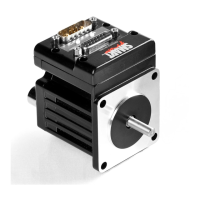Moog Animatics SmartMotor™ Developer's Guide,Rev. L
Page 593 of 909
MV
Mode Velocity
APPLICATION: Motion control
DESCRIPTION: Request velocity mode
EXECUTION: Buffered until a G command is issued
CONDITIONAL TO: N/A
LIMITATIONS: N/A
READ/REPORT: N/A
WRITE: N/A
LANGUAGE ACCESS: N/A
UNITS: N/A
RANGE OF VALUES: N/A
TYPICAL VALUES: N/A
DEFAULT VALUE: MP
FIRMWARE VERSION: 5.x and later
COMBITRONIC: MV:3 or MV(0):3
where ":3" is the motor address — use the actual address or a
variable
DETAILED DESCRIPTION:
The MV (Mode Velocity) command enables velocity mode. In this mode, the value of VT, the
target velocity, can be negative or positive. In contrast, position mode (MP) only uses the
magnitude of the velocity parameter. Acceleration and velocity can be changed at any time,
even during motion. The G command will initiate "on the fly" changes to any of the
parameters.
If the actual velocity is greater that the value defined by VT, then on reception of the next G
command, the motor shaft will decelerate at the rate set by ADT until the excess velocity is
removed. Conversely, if the actual velocity is less than VT when the G command is entered,
then the motor shaft motion will accelerate at the rate set by ADT until the requested velocity
is reached. Similarly, if the actual velocity is in the opposite direction of VT when the G
command is entered, then the motor shaft motion will first decelerate and then accelerate at
the rate set by ADT until the requested velocity is reached.
When the commanded velocity VT is reached, motion continues at that rate (i.e., maintains
uniform velocity until the commanded velocity is changed or the mode is otherwise
terminated). The encoder count may "wrap around" during this mode, but no position error
will be declared during the wrap.
The PID (servo) will be active. The MV mode calculates a ramp up to the specified velocity
based on the specified acceleration (ADT). The profile will stay at the velocity until
commanded to stop with an X command, which will decelerate the motor to a stop. The
velocity mode calculates position as a function of time. This is different than simpler velocity
Part 2: Commands: MV

